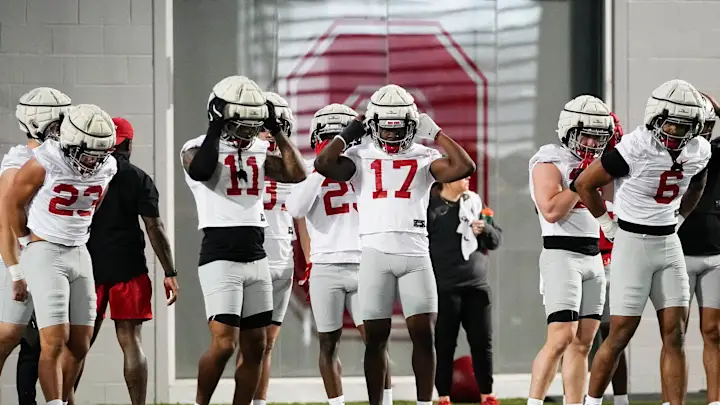Ohio State football has suffered another behind-the-scenes setback, one that won’t make as many headlines as a player decommitting or a big-game loss — but may prove just as impactful in the long run. A respected staff member is leaving Columbus to join an SEC program, and while such moves are not uncommon in today’s fluid college football landscape, this one raises significant concerns for the Buckeyes as they attempt to maintain national relevance on and off the field.
The loss isn’t necessarily about a high-profile coordinator or a frontline recruiter — it’s about continuity, culture, and momentum. These are the kinds of departures that chip away at the foundation of a program that has, for the last decade, been viewed as a model of consistency and elite performance. Now, with increased external pressure and mounting internal tension, Ohio State’s staffing infrastructure is being tested in ways it hasn’t in years.
It’s no secret that the SEC is the epicenter of modern college football. Programs like Georgia, Alabama, and LSU aren’t just dominating on Saturdays — they’re building all-star staffs with NFL-like precision. Support roles in recruiting, analytics, player development, and operations have become battlegrounds for talent acquisition just like the field itself. When an SEC program poaches an Ohio State staffer, it’s not simply a lateral move; it’s a signal of shifting tides. These moves reflect perception, opportunity, and ambition.
From a recruiting standpoint, losing an off-field staffer can often mean more than losing a single assistant coach. These are the people who manage relationships, keep communication flowing, handle logistics, and provide the backbone to multi-million-dollar operations. They are the ones who maintain daily contact with recruits and their families, ensure player transitions are smooth, and play critical roles in maintaining the “machine” that top-tier football programs require. Losing someone experienced and well-connected to an SEC rival is more than a simple resume change — it’s a strategic blow.
So what does this latest departure say about Ohio State? For one, it raises questions about staff retention. In a year where the Buckeyes are already fighting uphill battles on the recruiting trail, the last thing they need is to appear unstable or internally fragmented. Every exit — whether it’s a player, coach, or support staff member — adds to a narrative that things aren’t as buttoned up as they used to be in Columbus.
This is particularly troubling given the broader context. Ohio State is facing increased scrutiny after consecutive losses to Michigan and a few high-profile recruiting misses. The margin for error has shrunk considerably. Programs can no longer afford to simply replace key staffers without a ripple effect. Continuity is now a competitive advantage, and when that begins to erode, so does the ability to compete with the Alabamas and Georgias of the world.
The fact that the departure is to an SEC school only adds to the sting. The SEC isn’t just pulling players from Ohio State’s recruiting pipeline — it’s now coming after their staff. That sends a message not only to rival programs but to high school recruits and their families: the SEC is where the action is, where the money is, and increasingly, where the talent behind the talent is going. If you’re a young rising staffer looking to make your mark in the industry, are you more likely to see your future in Columbus or in Athens, Tuscaloosa, or Baton Rouge?

These moves don’t happen in a vacuum. Support staff talk. They know which programs are investing, which environments are healthy, which head coaches provide upward mobility and support. When a valued staffer leaves Ohio State, it forces internal reflection: Was the staff member underpaid? Overworked? Were they not given a clear path to promotion? Or do they simply see better growth opportunities in the SEC? None of these answers are particularly comforting if you’re a Buckeyes fan hoping to see the program regain its recruiting and developmental edge.
For Ryan Day, this adds one more item to an increasingly complex to-do list. Day, often praised for his offensive brilliance and calm leadership, now finds himself needing to recalibrate the operational structure of the program. It’s not just about play calling anymore — it’s about building a sustainable, forward-looking staff that can compete not only on the sideline but in the shadows, where championships are also forged.
Some may brush off this move as part of the natural coaching cycle. After all, staffers move all the time. That’s true — but the pattern is what matters. In the past 18 months, Ohio State has experienced more turnover in both its on-field and off-field positions than it did in the prior three years combined. From strength and conditioning coaches to recruiting coordinators, the revolving door has started to spin faster. In a vacuum, each departure is manageable. Taken together, they suggest a program in flux.
This latest departure could also have recruiting implications. Staffers build long-term relationships with recruits, especially the ones in the class of 2025 and 2026. These are the people who guide prospects through the process, text them on holidays, reassure them after tough losses, and keep them feeling valued. When those figures leave, even if the head coach remains, the bond is weakened. It opens the door for rival programs to swoop in, question the program’s direction, and flip once-solid commitments.
There’s also the timing factor to consider. With the college football season just around the corner, continuity is vital. A staff reshuffling this late in the offseason means added pressure on those who remain. Adjustments have to be made quickly. Players — especially early enrollees and freshmen — feel the effects more than anyone. A staffer they trusted is suddenly gone, and a new face is trying to build rapport from scratch. That’s not ideal heading into what could be a make-or-break year for Ryan Day and the Buckeyes.
In contrast, SEC programs appear to be building for the long haul with greater cohesion and consistency. Georgia has built a veritable army of analysts and recruiting personnel, many of whom have been poached from top programs like Ohio State. Alabama continues to reload not just on the field but behind the scenes, hiring talented young minds and experienced developers alike. These programs understand that every edge matters. They know that the road to championships doesn’t just run through quarterback play — it runs through the structure and stability of the entire operation.
If Ohio State wants to return to the elite level and stay there, it must take a hard look at how it handles staffing. That means competitive pay. That means clear career paths. That means adapting to a new world where NIL, media access, and player development are all intertwined with how a program is run. It’s no longer enough to have a great head coach or a talented roster. The entire apparatus — from the assistant strength coach to the recruiting graphic designer — plays a part in shaping outcomes.
There’s still time to course correct. Ohio State has the resources, tradition, and brand power to reestablish itself as a destination not just for top players, but for top personnel. But it must recognize that in the arms race that is modern college football, standing still is falling behind. Losing a key staffer to an SEC school isn’t just a bump in the road — it’s a warning sign. And how the Buckeyes respond could determine whether they remain part of the sport’s elite or continue to slide into second-tier status.
The ball is in Ryan Day’s court. Rebuild the staff with vision and urgency. Show recruits and insiders alike that Ohio State is not a stepping stone but a career-defining destination. Because if more staffers continue to walk out the door toward the SEC, the Buckeyes risk losing much more than just bodies — they risk losing their identity.



